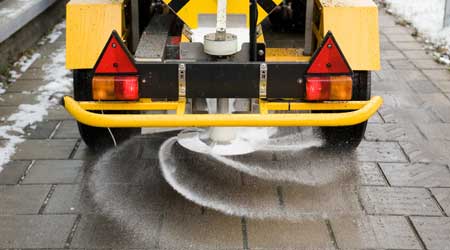Alternative Strategies, Chemicals May Eliminate Rock Salt in Snow Removal
Pre-spreading salt brine and using potassium formate may allow facility managers to eliminate rock salt from their snow removal strategy.
Another way to cut the amount of salt used is by spreading salt brine before the storm hits, rather than waiting until the snow is on the ground and trying to melt it with rock salt, Gilleland says. The idea is to “get away from de-icing and toward anti-icing,” he says, adding that an application of brine can reduce the amount of chloride needed to melt snow on a parking lot by about 90 percent.
The salt itself doesn’t melt anything; rather, it has to turn to brine in order to work, Gilleland says. “When you apply rock salt, it sits there for some length of time before it turns to brine,” he says. Applying salt as brine accelerates this process.
Moreover, the brine can be applied in advance, as it doesn’t wear off. Instead, it “just dries, and waits for the moisture to come,” Gilleland says. Many departments of transportation apply brine to bridges and steep inclines ahead of storms, to head off slipperiness, he adds.
Some organizations use different liquids, such as cheese whey or beet juice, to create the brine. These liquids can lower the freezing point of the brine, which also can cut the amount of salt used, Gould says.
Michigan State University uses a liquid de-icer derived from beet juice to melt snow on roads and walkways. According to the university, “the organic de-icer is also more effective under colder weather conditions than traditional salt because it melts the snow and ice at lower temperatures.”
What about other chemicals?
Another chemical, potassium formate, can help with snow and ice removal, is readily biodegradable, and doesn’t harm pets, concrete, or plants, Clemmer says. (His company is behind Entry, a deicing product in which potassium formate is the main ingredient.) It works to temperatures well below zero degrees F.
“Potassium formate has been used for a long time on airport runways, and it’s an exciting option,” Welzer of Green Seal says.
While the product is more expensive than rock salt, it’s not tracked back into the building and so doesn’t create the maintenance challenges that salt can, Clemmer says.
Sexton says WIT tested a chloride free de-icing product, primarily blended with potassium formate, similar to that used by the aviation industry to melt snow and ice on runways without causing corrosion issues for airplanes. “Through all the research we’ve done, it’s the only one that doesn’t seem to have some other unintended environmental impact.”
Related Topics:














